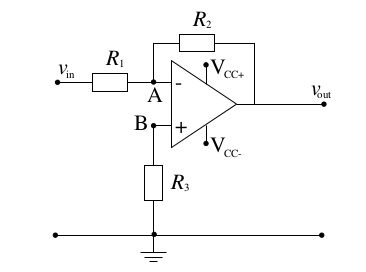@DaveTweed wrote a good verbal proof for \$R_{3}=\dfrac{R_1R_2}{R_1+R_2}=R_1||R_2\$.
Here's an algebraic version.
Let's drop the ideal op-amp assumption that op-amp input currents \$I_{b+}\$ and \$I_{b-}\$ are zero.
\$I_b=I_{b+}=I_{b-}\neq0\$
In practice, \$I_b\$ can vary between different batches of ICs. \$I_b\$ isn't known. Let's assume that it's fixed.

First, consider the case without compensation resistor, \$R_3=0\$.
\$\dfrac{V_{in}}{R_1}+\dfrac{V_{out}}{R_2}+I_b =0\$,
\$V_{out}=-V_{in}\dfrac{R_2}{R_1}-I_bR_2\$
Notice the \$I_b R_2\$ nuisance.
Second, consider \$R_3\neq0\$. Let's find \$R_3\$ such that \$V_{out}\$ is closest to \$-V_{in}\dfrac{R_2}{R_1}\$
Voltage at the positive input: \$V_{(+)}=I_bR_3\$
\$\dfrac{V_{in}-I_bR_3}{R_1}+\dfrac{V_{out}-I_bR_3}{R_2}+I_b=0\$
\$\dfrac{V_{in}}{R_1}+\dfrac{V_{out}}{R_2}+I_b\left(\dfrac{R_3}{R_1}+\dfrac{R_3}{R_2}-1 \right)=0\$
Notice the \$I_b\left(\dfrac{R_3}{R_1}+\dfrac{R_3}{R_2}-1 \right)\$ nuisance. Let's equate it to 0 and solve for \$ R_3 \$.
\$I_b\left(\dfrac{R_3}{R_1}+\dfrac{R_3}{R_2}-1 \right)=0\$, when \$\dfrac{R_3}{R_1}+\dfrac{R_3}{R_2}=1\$
which can be solved for \$R_{3}=\dfrac{R_1R_2}{R_1+R_2}=R_1||R_2\$
Extra:
I made an assumption that \$ I_{b+}=I_{b-} \$ (the input currents are equal).
How good is this assumption?
The average of the input currents is called the input bias current \$ I_b = \dfrac{I_{b+} + I_{b-}}{2} \$, and the difference is called input offset current \$ I_{OS} = I_{b+} - I_{b-}\$.
\$ I_b\$ and \$ I_{OS}\$ are mentioned in the datasheets. Usually \$ I_{OS}\$ is significantly smaller than \$ I_b\$. For example, LM324 has \$ I_b\$ = -60 nA max and \$ I_{OS}\$ = ±5 nA max.
The output error due to input currents
\$ E_O = \left(1 + \cfrac{R_2}{R_1} \right) \left( \left( R_1 || R_2 \right) I_{b-} - R_3 I_{b+} \right) \$
Substituting \$ I_{b+} = I_b + \cfrac{I_{OS}}{2}\$ and \$ I_{b-} = I_b - \cfrac{I_{OS}}{2}\$ , then factoring out \$ I_b\$ and \$ I_{OS}\$ .
\$ E_O = \left(1 + \cfrac{R_2}{R_1} \right) \left( \left( \left( R_1 || R_2 \right) - R_3 \right) I_b - \cfrac{1}{2} \left( \left( R_1 || R_2 \right) + R_3 \right) I_{OS} \right) \$
Like before we choose \$ R_3 = R_1 || R_2\$ .
The \$ I_b\$ term collapses and the error reduces to
\$ E_O = \left(1 + \cfrac{R_2}{R_1} \right) \left( - R_1 || R_2 \right) I_{OS} \$
The error can be reduced further by reducing the values of \$ R_1\$ and \$ R_2\$ while
preserving the ratio \$ R_2 / R_1\$ .





